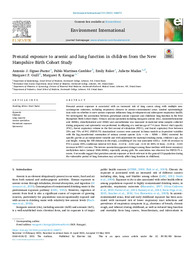Título :
Prenatal exposure to arsenic and lung function in children from the New Hampshire Birth Cohort Study |
Autor :
Signes-Pastor, Antonio Jose 
Martínez-Camblor, Pablo 
Baker, Emily 
Madan, Juliette 
Guill, Margaret F.
Karagas, Margaret R  |
Editor :
Elsevier |
Departamento:
Departamentos de la UMH::Salud Pública, Historia de la Ciencia y Ginecología |
Fecha de publicación:
2021 |
URI :
https://hdl.handle.net/11000/30790 |
Resumen :
Prenatal arsenic exposure is associated with an increased risk of lung cancer along with multiple noncarcinogenic outcomes, including respiratory diseases in arsenic- contaminated areas. Limited epidemiologic data exist on whether in utero arsenic exposure influences lung development and subsequent respiratory health.
We investigated the association between gestational arsenic exposure and childhood lung function in the New Hampshire Birth Cohort Study. Urinary arsenic speciation including inorganic arsenic (iAs), monomethylarsonic acid (MMA), dimethylarsinic acid (DMA) and arsenobetaine was measured in maternal urine samples collected
during pregnancy and spirometry was performed in offspring at a median age of 7.4 years. Forced vital capacity (FVC), forced expiratory volume in the first second of exhalation (FEV1), and forced expiratory flow between 25% and 75% of FVC (FEF25-75) standardized z-scores were assessed in linear models as dependent variables with the log2-transformed summation of urinary arsenic species (ΣAs = iAs + MMA + DMA) corrected for specific gravity as an independent variable and with adjustment for maternal smoking status, children’s age, sex and height. Among the 358 children in the study, a doubling of ΣAs was associated with a - 0.08 (ß) decrease in FVC z-scores (95% confidence interval (CI) from - 0.14 to -0.01) and - 0.10 (ß) (95% CI from - 0.18 to - 0.02)
decrease in FEV1 z-scores. The inverse association appeared stronger among those mothers with lower secondary methylation index (urinary DMA/MMA), especially among girls. No association was observed for FEF25-75 zscores. Our results suggest that gestation arsenic exposure at levels relevant to the general US population during
the vulnerable period of lung formation may adversely affect lung function in childhood.
|
Palabras clave/Materias:
Children
Lung capacity
Arsenic speciation
Gestational exposure
Spirometry |
Tipo de documento :
info:eu-repo/semantics/article |
Derechos de acceso:
info:eu-repo/semantics/openAccess
Attribution-NonCommercial-NoDerivatives 4.0 Internacional |
DOI :
https://doi.org/10.1016/j.envint.2021.106673 |
Publicado en:
Environment International. 2021 Oct:155:106673 |
Aparece en las colecciones:
Artículos Salud Pública, Historia de la Ciencia y Ginecología
|

 La licencia se describe como: Atribución-NonComercial-NoDerivada 4.0 Internacional.
La licencia se describe como: Atribución-NonComercial-NoDerivada 4.0 Internacional.
.png)